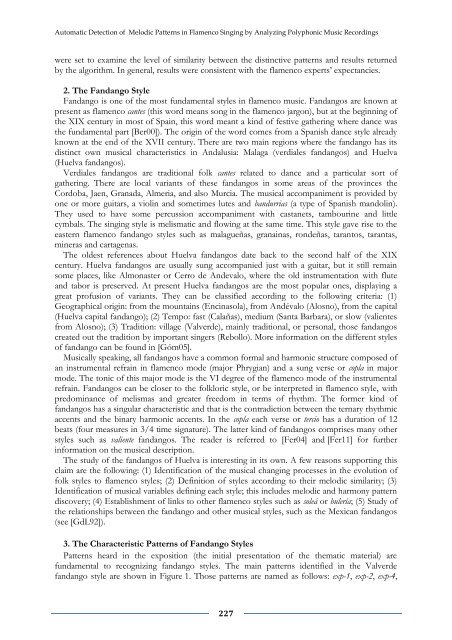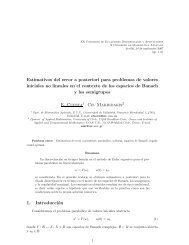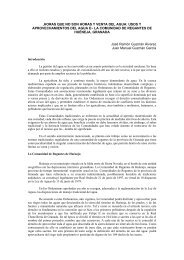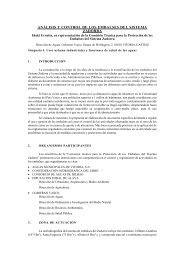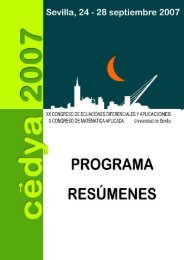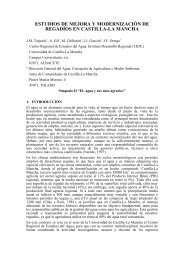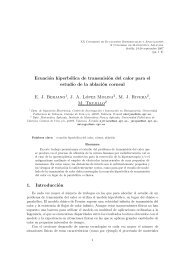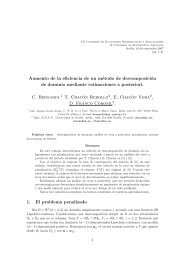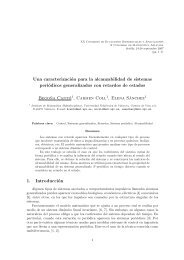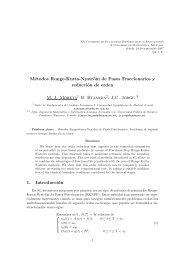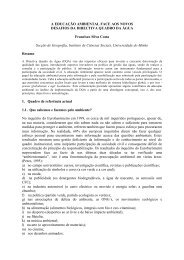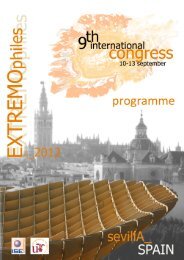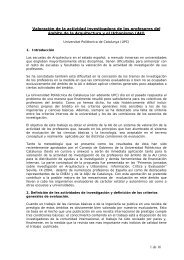LIBRO DE ACTAS (pdf) - Universidad de Sevilla
LIBRO DE ACTAS (pdf) - Universidad de Sevilla
LIBRO DE ACTAS (pdf) - Universidad de Sevilla
You also want an ePaper? Increase the reach of your titles
YUMPU automatically turns print PDFs into web optimized ePapers that Google loves.
Automatic Detection of Melodic Patterns in Flamenco Singing by Analyzing Polyphonic Music Recordings<br />
were set to examine the level of similarity between the distinctive patterns and results returned<br />
by the algorithm. In general, results were consistent with the flamenco experts’ expectancies.<br />
2. The Fandango Style<br />
Fandango is one of the most fundamental styles in flamenco music. Fandangos are known at<br />
present as flamenco cantes (this word means song in the flamenco jargon), but at the beginning of<br />
the XIX century in most of Spain, this word meant a kind of festive gathering where dance was<br />
the fundamental part [Ber00]). The origin of the word comes from a Spanish dance style already<br />
known at the end of the XVII century. There are two main regions where the fandango has its<br />
distinct own musical characteristics in Andalusia: Malaga (verdiales fandangos) and Huelva<br />
(Huelva fandangos).<br />
Verdiales fandangos are traditional folk cantes related to dance and a particular sort of<br />
gathering. There are local variants of these fandangos in some areas of the provinces the<br />
Cordoba, Jaen, Granada, Almeria, and also Murcia. The musical accompaniment is provi<strong>de</strong>d by<br />
one or more guitars, a violin and sometimes lutes and bandurrias (a type of Spanish mandolin).<br />
They used to have some percussion accompaniment with castanets, tambourine and little<br />
cymbals. The singing style is melismatic and flowing at the same time. This style gave rise to the<br />
eastern flamenco fandango styles such as malagueñas, granainas, ron<strong>de</strong>ñas, tarantos, tarantas,<br />
mineras and cartagenas.<br />
The ol<strong>de</strong>st references about Huelva fandangos date back to the second half of the XIX<br />
century. Huelva fandangos are usually sung accompanied just with a guitar, but it still remain<br />
some places, like Almonaster or Cerro <strong>de</strong> An<strong>de</strong>valo, where the old instrumentation with flute<br />
and tabor is preserved. At present Huelva fandangos are the most popular ones, displaying a<br />
great profusion of variants. They can be classified according to the following criteria: (1)<br />
Geographical origin: from the mountains (Encinasola), from Andévalo (Alosno), from the capital<br />
(Huelva capital fandango); (2) Tempo: fast (Calañas), medium (Santa Barbara), or slow (valientes<br />
from Alosno); (3) Tradition: village (Valver<strong>de</strong>), mainly traditional, or personal, those fandangos<br />
created out the tradition by important singers (Rebollo). More information on the different styles<br />
of fandango can be found in [Góm05].<br />
Musically speaking, all fandangos have a common formal and harmonic structure composed of<br />
an instrumental refrain in flamenco mo<strong>de</strong> (major Phrygian) and a sung verse or copla in major<br />
mo<strong>de</strong>. The tonic of this major mo<strong>de</strong> is the VI <strong>de</strong>gree of the flamenco mo<strong>de</strong> of the instrumental<br />
refrain. Fandangos can be closer to the folkloric style, or be interpreted in flamenco style, with<br />
predominance of melismas and greater freedom in terms of rhythm. The former kind of<br />
fandangos has a singular characteristic and that is the contradiction between the ternary rhythmic<br />
accents and the binary harmonic accents. In the copla each verse or tercio has a duration of 12<br />
beats (four measures in 3/4 time signature). The latter kind of fandangos comprises many other<br />
styles such as valiente fandangos. The rea<strong>de</strong>r is referred to [Fer04] and [Fer11] for further<br />
information on the musical <strong>de</strong>scription.<br />
The study of the fandangos of Huelva is interesting in its own. A few reasons supporting this<br />
claim are the following: (1) I<strong>de</strong>ntification of the musical changing processes in the evolution of<br />
folk styles to flamenco styles; (2) Definition of styles according to their melodic similarity; (3)<br />
I<strong>de</strong>ntification of musical variables <strong>de</strong>fining each style; this inclu<strong>de</strong>s melodic and harmony pattern<br />
discovery; (4) Establishment of links to other flamenco styles such as soleá or bulería; (5) Study of<br />
the relationships between the fandango and other musical styles, such as the Mexican fandangos<br />
(see [GdL92]).<br />
3. The Characteristic Patterns of Fandango Styles<br />
Patterns heard in the exposition (the initial presentation of the thematic material) are<br />
fundamental to recognizing fandango styles. The main patterns i<strong>de</strong>ntified in the Valver<strong>de</strong><br />
fandango style are shown in Figure 1. Those patterns are named as follows: exp-1, exp-2, exp-4,<br />
227


